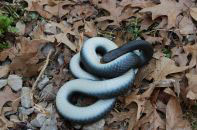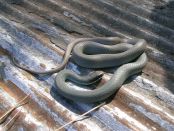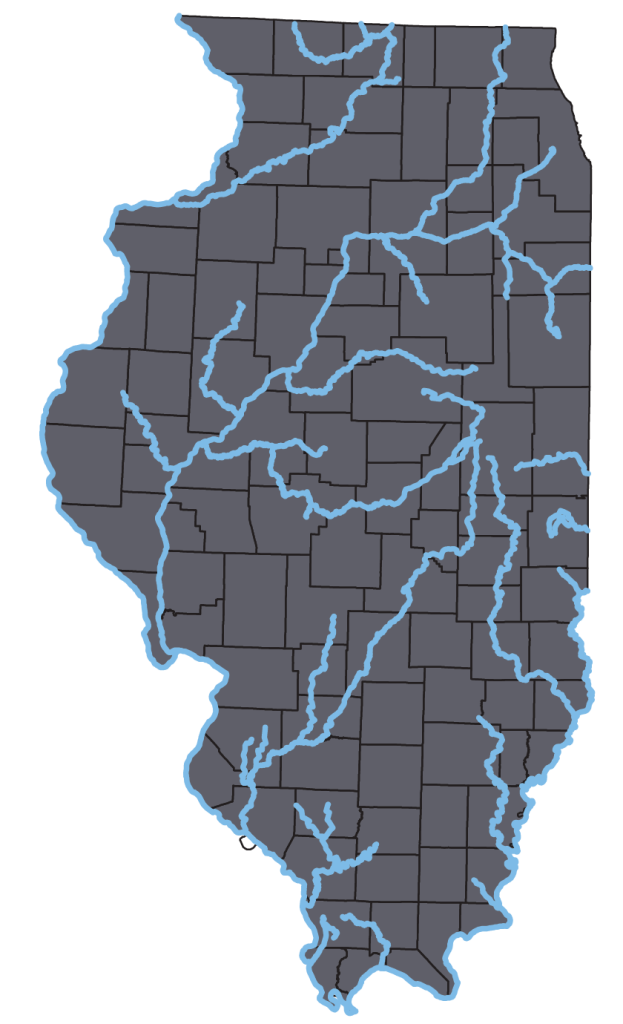Coluber constrictor (Linnaeus, 1758)

Key Characters: Plain black or bluish black; smooth scales; divided anal plate; juveniles heavily marked with small blotches.
Similar Species: Adults resemble the Gray Ratsnake, Coachwhip, and Plain-bellied Watersnake; juveniles resemble young of Gray Ratsnake, Coachwhip, Foxsnake, Yellow-bellied Kingsnake, Milksnake, and water snakes. See the Key to Snakes of Illinois for help with identification.
Subspecies: Eleven subspecies are currently recognized, but only two, Blue Racer, C. c. foxii (Baird & Girard, 1853); Southern Black Racer, C. c. priapus Dunn & Wood, 1939 are thought to inhabit Illinois.


Description: Adult long (up to 150 cm TL) and slender with shiny, uniformly blue, blue-green, or black back. Belly yellowish white to slate gray. Throat distinctly lighter (yellow in northwest, white elsewhere). Hatchling and juvenile up to about 80 cm TL, blue-gray with 55-85 reddish brown blotches on back that become less distinct toward tail, and small dark spots along sides and belly.
Habitat: A variety of habitats including forests, open areas, and edges of forests near open fields.
Natural History: Alert and agile, often raises its head above the ground to look around, and reacts to disturbance by moving away quickly. If cornered, vibrates the tail tip and can be counted on to strike repeatedly. Mates in May and June and female lays 10-20 eggs in late June or July. The young, 20-35 cm TL, hatch in September. Eats a variety of animals, including arthropods, worms, amphibians, reptiles, birds, and small mammals. Main predators are other snakes and raptors.
Status: Locally common in some parts of the state.
Etymology: Coluber – (Latin) meaning snake; constrictor – constrictus (Latin) meaning ‘drawn together’; foxii – (New Latin) patronym for Charles Fox (1815-1854); priapus – Priapus (Latin) Roman god of male creative power.
Original Description: Linnaeus, C. 1758. Systema Naturae per Regina tri Naturae secundum Classes, Ordines, Genera, Species, cum Characteribus, Differentiis, Synonymis, Locis. 10th ed. Salvii, Stockholm. For foxii: Baird, S. F. and C. Girard. 1853. Catalogue of North American Reptiles in the Museum of the Smithsonian Institution. Part 1.-Serpents. Smithsonian Inst., Washington, xvi + 172 pp. For priapus, Dunn,E.R. and Wood,G.C. 1939. Notes on eastern snakes of the genus Coluber. Notulae Naturae Philadelphia, No. 5: 1-4
Type Specimen: Not designated. For foxii, Holotype. USNM 4445. For priapus, “West Palm Beach, Florida”.
Type Locality: “America septentrionale”. For foxii, “Gros Isle. Mich.”. For priapus, “West Palm Beach, Florida”.
Original Name: Coluber constrictor Linnaeus, 1758. For foxii, Basconion foxii Baird & Girard, 1853. For priapus, Coluber constrictor priapus Dunn & Wood, 1939.
Nomenclatural History: It was transferred to the genus Basconion by Baird & Girard (1853), which is how Kennicott (1855) and Davis & Rice (1883) listed it. Garman (1892) used the current name. Smith (1961) listed two subspecies in Illinois, C. c. flaviventris Say, 1823, Eastern Yellow-bellied Racer found in most of the state, and C. c. flaviventris x C. c. priapus intergrades in extreme southern Illinois. The range of flaviventris is now known to be west of the Mississippi.


